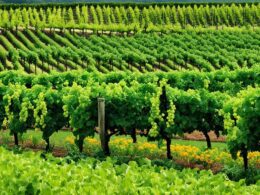Oak trees are renowned for their rapid growth and resilience, making them a popular choice for landscaping and urban environments. If you’ve ever wondered about the growth rate of these majestic trees, you’re in the right place.
Fast-growing oak trees can reach impressive heights and widths, providing both beauty and environmental value to your landscape. On average, oak trees can grow from 1 to 3 feet per year throughout their lifetime. However, the fastest growth occurs during the initial 10 to 15 years. During this period, young oak trees can grow at a staggering rate of 2 to 3 feet per year.
These growth rates make oak trees ideal as street trees, as they quickly provide shade and can tolerate urban pollution. Additionally, if you have enough space in your yard, oak trees make excellent shade trees that contribute positively to the environment.
Several oak tree species are known for their fast growth. The Northern Red Oak, Shumard Oak, and Willow Oak are among the most popular choices for homeowners and landscapers. These species not only provide aesthetic appeal but also offer various environmental benefits.
Factors such as environmental conditions, oak tree species, site conditions, and maintenance practices can influence the growth of oak trees. By understanding these growth factors and stages, you can create the optimal conditions for your oak tree’s development and ensure its longevity.
Factors Influencing Oak Tree Growth
The growth of oak trees is influenced by various factors that contribute to their health and overall development. To ensure optimal growth and longevity, it is essential to consider several key elements.
Environmental Conditions:
- Climate: Oak trees thrive in temperate climates, with a preference for moderate rainfall and well-defined seasons.
- Soil Type: Different oak tree species have specific soil preferences. While some thrive in well-drained sandy soil, others prefer loamy or clay soil.
- Sunlight: Oak trees require ample sunlight for photosynthesis and optimal growth. A minimum of six hours of direct sunlight per day is recommended.
- Water Availability: Adequate water availability is crucial for oak tree growth. It is important to ensure consistent watering, particularly during dry spells.
- Nutrient Levels: The soil’s nutrient composition plays a vital role in oak tree growth. Regular soil testing can help determine if any amendments are needed.
Oak Tree Species and Growth Rates:
Various oak tree species exhibit different growth rates and characteristics. Some species, such as the Northern Red Oak, Shumard Oak, and Willow Oak, are known for their fast growth, while others, like the White Oak, have a slower growth rate. It is crucial to select the appropriate oak tree species based on the desired growth rate and overall landscape vision.
Site Conditions:
The quality of the planting site significantly influences oak tree growth. Consider the following factors:
- Soil Fertility: Ensure the soil is rich in nutrients and organic matter to provide the necessary foundation for robust root development.
- Drainage: Proper drainage is essential to prevent waterlogged soil, which can hinder root growth and lead to root rot.
- pH Levels: Oak trees generally prefer slightly acidic to neutral soil with a pH range of 6.0 to 7.5. Adjusting the pH level, if necessary, can optimize growth.
Maintenance Practices for Healthy Growth:
Maintaining the health of oak trees involves specific care practices:
- Regular Watering: Ensure the tree receives adequate water, especially during dry periods, to promote healthy root growth and overall vigor.
- Mulching: Apply a layer of organic mulch around the tree’s base to conserve moisture, regulate soil temperature, and suppress weed growth.
- Pruning: Prune oak trees during their dormant season to remove dead, diseased, or damaged branches, allowing for improved airflow and reducing the risk of pest and disease infestation.
- Pest and Disease Management: Monitor and address any signs of pests or diseases promptly to prevent damage to the tree’s health and growth.
Creating optimal environmental conditions, selecting suitable oak tree species, considering site conditions, and implementing proper maintenance practices are vital for ensuring healthy oak tree growth and longevity.
Will Using Pine Tree Fertilizer Also Promote Growth in Oak Trees?
Fertilizing pine trees effectively is crucial for their growth, but it may not have the same effect on oak trees. Different tree species have varying nutrient needs, so using pine tree fertilizer may not promote growth in oak trees. It’s important to use the right fertilizer for each specific tree species.
The Growth Stages of Oak Trees
Oak trees, known for their strength and endurance, go through distinct growth stages during their lifespan. Understanding these stages can help you appreciate their journey and care for them properly.
The first stage is the germination and seedling stage. At this point, a tiny seedling emerges from an acorn, taking root in the soil. It begins to establish its root system, preparing for future growth.
In the young sapling stage, the oak tree grows taller and develops a stronger root system. It starts producing more leaves and branches, expanding in both height and width. This stage is crucial for the oak tree’s development, as it lays the foundation for its future growth.
As the oak tree matures, it enters the mature tree stage. Here, the tree reaches its full height and spreads its branches wide. It becomes a majestic presence in the landscape. During this stage, the oak tree produces acorns, which serve as a vital source of food for wildlife and contribute to the surrounding ecosystem.
Oak trees are renowned for their longevity. They can live for several decades, or even centuries, continuing to thrive and support their ecosystem. While their growth may slow down once they reach maturity, their significance remains undiminished.
Embracing the growth stages of oak trees allows us to marvel at their endurance and appreciate the patience required to nurture these magnificent beings. Whether you have an oak tree in your yard or encounter one in nature, take a moment to admire its journey and the legacy it leaves behind.









